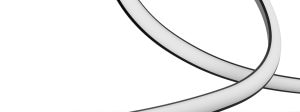One of the biggest appeals to LED strip lighting is its adaptability. By cutting your LED strip lights, you can display your stream of light seamlessly around corners. Whether you want to add extra illumination to your kitchen work surfaces or provide a backlight for your TV, LED strips can be trimmed to fit your needs and space.
Can you cut LED strip lights?
How to cut LED strip lights
While LED strip lights are adaptable, it's important to cut them in the right place to make sure they continue working. LED strips are made up of multiple individual circuits. The designated cut lines mark the end of one circuit and the beginning of another. Therefore, you should only cut along these lines, which are usually located between copper dots.
Where to cut LED light strips
As long as you only cut along the marked cut lines, LED strips – including certain Philips Hue lightstrips – will work after cutting. Many people experience issues with their LED strip lights if they cut outside of these lines. The cut lines are also the safest place to cut LED strips, as the circuits here are closed.
Can you cut Philips Hue strip lights and re-use the cut parts?
Firstly, not all Philips Hue strip lights are cuttable, including all current outdoor strip lights, owing to their weather-resistant design. Many strip lights are cuttable, and some even allow the cut parts to be reused and added to the strip light using a connector. Lightstrip V4 and many of the latest models will enable this level of customization. Many earlier strip light models can only be cut to size, but do not allow the cut parts to be reused. Be sure to check the strip light's specifications to ensure it's suitable for your needs.
How to bend an LED strip light
LED strip lights are designed to bend with ease. If you want to curve your strip light around surfaces, or the back of your TV or computer screen, there are two options to do it effectively.
1. Bending an LED strip directly
The simplest technique is to bend your LED strip directly, but it's important to only bend on the designated cut lines to avoid damaging the strip light. Philips Hue lightstrips provide clear cut lines to help you do this.
2. Using a connector to bend your LED strip 90 degrees
If you want your strip light to go around a right-angle corner, such as along the corner of a work surface or in line with the stairs, using a corner connector is the best approach. Corner connectors are L-shaped and allow you to easily connect two pieces of LED strips. They give a better overall finish compared to trying to bend strip lights around right-angle corners directly.
Discover a variety of Philips Hue lightstrips that are bendable and cuttable.

